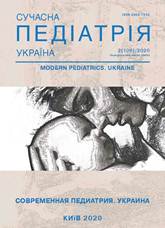Influence of early renoprotections on slow progression of chronic kidney disease in children
Keywords:
chronic kidney disease, children, renoprotection, enalapril, glomerular filtration rate, cystatin C, albumin excretion rate, albumin-to-creatinine ratio, serum potassiumAbstract
Objective: to evaluate the effect of early renoprotection on slowing the progression of chronic kidney disease in children (CKD).
Materials and methods. The effect of 5-year renoprotective therapy with an angiotensin-converting enzyme inhibitor (ACE inhibitor), enalapril, at a rate of 0.2–0.4 mg/kg per day, on the slowdown of the progression of CKD 1 st. in 25 children, based on a study of the dynamics of glomerular filtration rate (GFR), cystatin C (Cs C) level, albumin excretion rate (AER), albumin-to-creatinine ratio (ACR), 24-hour proteinuria, and serum potassium (SP) level.
Results. The use of enalapril reduced AER in daily urine from 141.4±10.1 mg/24 hours. up to 67.5±6.1 mg/24 hours after 5 years of treatment (p<0,001). ACR in daily urine decreased from 2.52±0.31 mg/mmol to 1.43±0.18 mg/mmol after 5 years of renoprotective therapy (p<0,01). Under the influence of treatment, the level of GFR increased on average by 4–8 ml/min/1.73 m2 in comparison with the initial data (after 1 year — p<0,01; after 5 years — p<0,05). The dynamics of Cs C showed a significant decrease in the values of this indicator from 0.77±0.0016 mg/l to 0.7±0.013 mg/l after 1 year (p<0.001) and to 0.71±0.014 mg/l after 5 years (p<0.01) renoprotective therapy. The concentration of SC during treatment was within the reference values in 92.0% of patients. After 1 year and slowing the progression of CKD 1 tbsp. achieved in 88,0% of the examined patients, after 5 years — in 92,0% of patients.
Conclusions. The early antiproteinuric effect of ACE inhibitors is associated with prolonged preservation of renal function in children with CKD. Reducing albuminuria, ACR and proteinuria should be considered an important goal in the treatment of CKD in children.
The research was carried out in accordance with the principles of the Helsinki Declaration. The study protocol was approved by the Local Ethics Committee of an participating institution. The informed consent of the patient was obtained for conducting the studies.
References
Ardissino G, Vigano S, Testa S et al. (2007). No clear evidence of ACEi efficacy on the progression of chronic kidney disease in children with hypodysplastic nephropathy-report from the ItalKid Project database. Nephrol. Dial. Transplant. 22(9): 2525—2530. https://doi.org/10.1093/ndt/gfm237; PMid:17526542
Czarniak P, Zurowska A. (2014). Treatment strategies to prevent renal damage in hypertensive children. Curr. Hypertens. Rep. 16(4): 423. https://doi.org/10.1007/s11906-014-0423-2; PMid:24522942 PMCid:PMC3960483
Flynn JT, Mitsnefes М, Pierce С et al. (2008). Blood pressure in children with chronic kidney disease: a report from the Chronic Kidney Disease in Children study. Hypertension. 52(4): 631—637. https://doi.org/10.1161/HYPERTENSIONAHA.108.110635; PMid:18725579 PMCid:PMC3136362
Gross O, Licht С, Anders HJ et al. (2012). Early angiotensin-converting enzyme inhibition in Alport syndrome delays renal failure and improves life expectancy. Kidney Int. 81(5): 494–501. https://doi.org/10.1038/ki.2011.407; PMid:22166847
https://www.kidney.org/professionals/KDOQI/gfr_calculatorPed
Kidney Disease Outcomes Quality Initiative (K/DOQI) K/DOQI clinical practice guidelines on hypertension and antihypertensive agents in chronic kidney disease. (2004, May). Am J Kidney Dis. 43; 5(1): 1—290. https://doi.org/10.1053/j.ajkd.2004.03.003
Kidney Disease: Improving Global Outcomes (KDIGO) СKD Work Group. KDIGO 2012. (2013). Clinical Practice Guideline for the Evaluation and Management of Chronic Kidney Disease. Kidney Inter. Suppl. 3(1): 5–9. https://doi.org/10.1038/kisup.2012.73; PMCid:PMC4089625
Lurbe E, Cifkova R, Cruickshank JK et al. (2009). Management of high blood pressure in children and adolescents: recommendations of the European Society of Hypertension. J. Hypertens. 27(9): 1719–1742. https://doi.org/10.1097/HJH.0b013e32832f4f6b; PMid:19625970
National Kidney Foundation. (2002). K/DOQI Clinical Practice Guidelines for Chronic Kidney Diseases: Evaluation, Classification and Stratification. Am. J. Kidney Dis. 39 (1): 44–45.
Ruggenenti P, Perna А, Loriga G et al. (2005). Blood-pressure control for renoprotection in patients with non-diabetic chronic renal disease (REIN82): multicentre, randomised controlled trial. Lancet. 365(9463): 939–946. https://doi.org/10.1016/S0140-6736(05)71082-5
Van den Belt Sophie M, Heerspink Hiddo JL, Gracchi Valentina et al. (2018). Early proteinuria lowering by angiotensin-converting enzyme inhibition predicts renal survival in children with CKD. J. Am. Soc. Nephrol. 29(8): 2225–2233. https://doi.org/10.1681/ASN.2018010036; PMid:29930161 PMCid:PMC6065076
Van Dyck M, Proesmans W. (2004). Renoprotection by ACE inhibitors after severe hemolytic uremic syndrome. Pediatr. Nephrol. 19(6): 688–690. https://doi.org/10.1007/s00467-004-1451-y; PMid:15064939
Wuhl E, Trivelli A, Picca S et al. (2009). Strict blood-pressure control and progression of renal failure in children. N. Engl. J. Med. 361(17): 16390–1650. https://doi.org/10.1056/NEJMoa0902066; PMid:19846849
Downloads
Published
Issue
Section
License
The policy of the Journal “MODERN PEDIATRICS. UKRAINE” is compatible with the vast majority of funders' of open access and self-archiving policies. The journal provides immediate open access route being convinced that everyone – not only scientists - can benefit from research results, and publishes articles exclusively under open access distribution, with a Creative Commons Attribution-Noncommercial 4.0 international license (СС BY-NC).
Authors transfer the copyright to the Journal “MODERN PEDIATRICS. UKRAINE” when the manuscript is accepted for publication. Authors declare that this manuscript has not been published nor is under simultaneous consideration for publication elsewhere. After publication, the articles become freely available on-line to the public.
Readers have the right to use, distribute, and reproduce articles in any medium, provided the articles and the journal are properly cited.
The use of published materials for commercial purposes is strongly prohibited.

